#Almud
Explore tagged Tumblr posts
Text

Elevation map of Almud's oceans. This was far more painful to make than it looks. If you want to make a worldbuilder suffer, force them to think about plate tectonics.
#does this layout even make sense#would these elevations be possible on an actual planet#I don't know enough about geology to say for sure#I just did what made the most sense from the reference photos of Earth I had#elevation being higher where plates diverge was counterintuitive#but I guess it makes sense considering that volcanoes are a thing#all of this is subject to being edited#art#my art#Almud#worldbuilding#mapmaking#alien#spec bio#xenobiology
22 notes
·
View notes
Text
Questionnaire Answers: Akada
General Anatomy
LIMBS

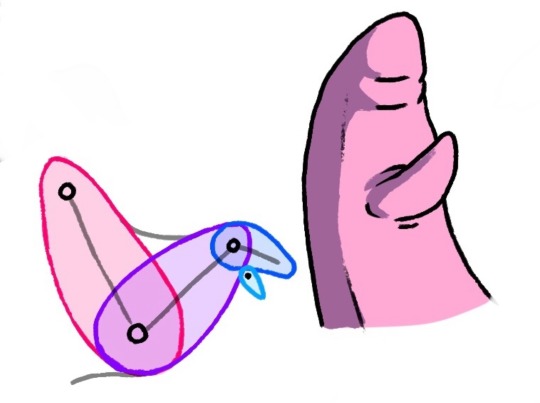
Akada have no legs, but they do have two arms, which are their primary manipulators. Even with how few fingers they have, their hands are extremely dextrous, much like an elephant's trunk or an octopus's tentacles. Also like these other animals, their arms, being made out of solid muscle, are incredibly strong, much moreso than you would probably expect by looking at them.
BODY COVERING
Most of an akada’s body is just plain skin. This skin has a bumpy, wrinkly texture, similar to Earth gastropods, and is covered by a thin layer of mucus. All that needs to be done to keep this skin healthy is regular bathing, just like what humans do.

They also have their shells, which have a similar chemical composition to silicate stone, but are fully organic. These shells must frequently be polished in the same way we humans brush our teeth, or else they may soften or become stained.

HABITAT AND ADAPTATIONS
Akada are terrestrial, mostly living in the tropical areas of their planet where their species originated. They have since spread out to the rest of the world, though they tend to avoid overly cold regions, only ever going there for more temporary visits like vacations or research excursions.
Similarly to melanin in humans, the pink pigmentation in their skin helps block out UV radiation, which there is a lot of in equatorial areas. Further north or south, populations of akada tend to have less of this pigment, leading to a more purpley or bluish coloration.

Fun fact: The above image was created in MS Paint, whereas all of the others were made in procreate. This is because I created it during the third revision of this post and didn't feel like going through the process of uploading any more photos from my phone onto my computer. Please excuse the general bad quality.
TEMPERATURE HOMEOSTASIS
Akada do not have the ability to regulate their internal body temperature. Instead, they use technology, such as clothing, heaters, or humidifiers to maintain their ideal hot, humid conditions or just live in areas that are always like that, such as tropical marshes and rainforests.
EVOLUTIONARY HISTORY
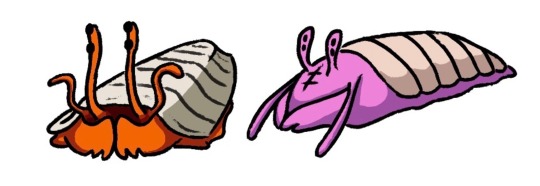
The creature on the left is the closest extant relative of akada. It is descended from the same social burrowing species as akada are, but unlike their cousins, never emerged above ground. As such, their bodies are built for a digging-centric lifestyle. For example, their flatter bodies are better for fitting through small crevices, and their paddle-like arms are better for tunneling through dirt. The chemical composition of their shells is also a bit different, being more similar to limestone than silicate, a difference owed to a slightly different diet. In terms of intelligence, they do have more brainpower than most creatures, but quite to the point where they can be considered sapient, being more comparable to a chimpanzee than a human.
The creature on the right is an extinct ancestor species to akada which had only recently moved from an underground habitat to the surface. While their bodies were very different, having lower heads and shorter arms, their brains were more or less the same as their modern counterparts, being capable of complex language, originally used to coordinate movement through and creation of tunnels, creative problem solving, which helped protect their soft, vulnerable bodies from predators, and abstract thought, which they used to just appreciate the beauty of the world whenever they had a moment of free time.
NECESSARY RESOURCES
Akada require a lot of water to survive, as their skin loses moisture very quickly. Most of this water is consumed through drinking, though some can also just be absorbed through the skin.
Additionally, due to the composition of their shells, they need to consume high amounts of calcium and silicon to stay healthy. What exactly they eat in order to meet this need will be described in more detail further down.
COMMON MUTATIONS
A common mutation akada can have is the formation of patterns on their shells. These patterns are the result of minerals not being evenly distributed throughout the shell during its formation, the same way certain stones can have colorful bands in them.
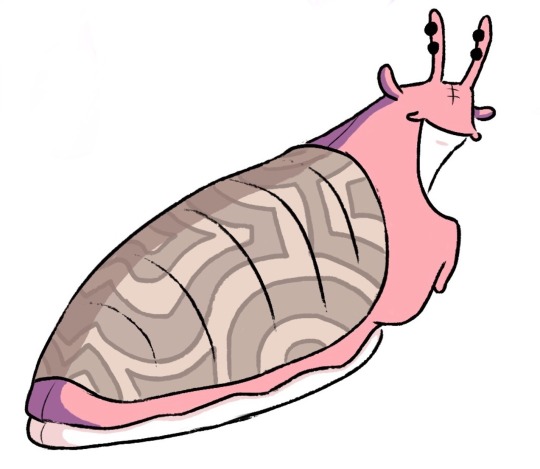
There are many different patterns that can form depending on how exactly the minerals are distributed. Below are four examples, though there are many more than this.

INJURIES AND HEALING
One of the most common injuries an akada can incur is a broken shell. Due to the size of the shell, it can take a while for any cracks to heal, but it doesn't do much to limit their mobility, so they can still live life fairly normally in the meantime.

Their soft parts, however, are much more easily healed, thanks to their powerful regenerative abilities. They can regrow any lost body part within a matter of weeks, no matter what part or how much they lose, though the regenerated flesh will always come back scarred and discolored. After the first regeneration, that particular part of the body will be a bit harder to grow back, a fact that will stack with each subsequent injury. It takes about five or six losses for a body part to become fully unregeneratable.

If you're wondering, that white circle is a nerve cord, not a bone. Akada do not have bones.
Senses
SENSES
Akada have all of the same senses that humans have, but rely a lot more on smell and vibration detection. This is a holdover from their days as a burrowing species, where sight wasn't as important to being able to tell where they were going. Their sight is not as good as that of humans, with most akada being at least a little bit nearsighted, but they do have corrective lenses they can use to make seeing things easier.
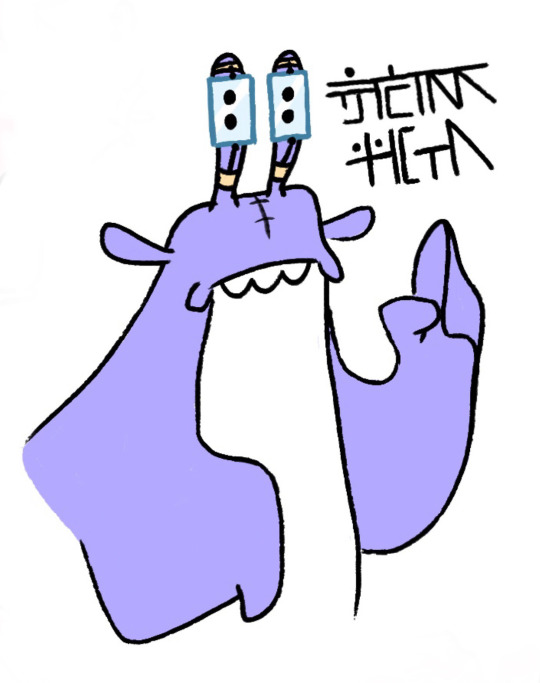
Movement
MOVEMENT METHODS
Akada move by slithering on the ground. It's slow and doesn't offer them a lot of agility, but they can do it for long periods of time without getting tired.
Because this is so slow, they often make use of vehicles to get from place to place. Individual akada often use small scooters or hoverboards to navigate streets more quickly than they could on foot, while groups will travel around in bullet trains or carts pulled by animals. Blimps are also quite popular, even with how slowly they move, as akada tend to have higher tolerance for long travel times than humans. Their slow movement and long lifespans make them naturally very patient.
Reproduction and Lifecycle
SEXES
By default, akada have both male and female reproductive organs. As such, most societies have no conception of gender, and the ones that do base their genders off of something non-sex-related, such as occupation or political ranking. It is possible for imperfect (male only/female only) akada to be born, but they are the exception rather than the norm, and this does not have any bearing on their gender identity.
COURTSHIP AND PARTNERSHIP
Akada attract mates through a method commonly known to humans as "asking politely". Typically, akada will form couples of three, all of which have the same roles and responsibilities, although tasks will typically be split between them for extra efficiency. Courtship is a mutual arrangement, and all participants must consent for it to become official.
BEAUTY STANDARDS
Things like shell hygiene, eyestalk length, and physical strength are taken into consideration when judging the attractiveness of others. Shell hygiene especially is seen as important, considering how immediately obvious any blemishes will be. Outside of that, it's hard to describe anything in exact detail, since beauty fads come and go about as frequently as they do on Earth, and often make just as little sense.
LIFESPAN
Akada live, on average, for about 120 Earth years/200 Almud years, at least with current medical technology. Future life expectancies will likely be much longer.
CHILDBIRTH AND CHILDCARE
Akada hatch from small eggs incubated in pools of warm water. In the early days of the species, these pools would usually be ponds or lakes, but in modern times, most groups use artificial vats.

Very little care is put into the aquatic larvae, which lack consciousnesses and are as a result not yet seen as people. Many of these larvae will die from either starvation or being eaten by other larvae, so only the largest and strongest will be able to metamorphose and emerge. Once they emerge from the water, however, younglings are pampered, raised with the help of the entire community, lasting from emergence until adulthood, with the town acting like an immense but ever-caring family. In short, akada use r-selection for their newborn young and K-selection for any that survive past infancy.
After emerging from the water, there are a few more changes that an akada's body will go through as they age, primarily just an increase in size and the enlongthenizing of their proportions. Outside of that, their shells also become harder and more deeply segmented, starting out as a smooth sheet of cartilage and becoming six fully distinct stony segments by mid-adolescence. The deepening of these grooves is often considered a sign that an akada is coming of age.
SEXUALITY
Nonreproductive sex between members of couples is common and expected. It is considered somewhat unusual for an akada to not have ever had sex, but it is not as frowned upon as it is among humans, since the more group-based society structure means less pressure is placed on the individual to produce offspring.
Diet and Foodchain
DIET
Akada are herbivores, primarily eating fruit, roots, and mold. They may also eat the discarded shells of clamlike creatures that wash up on shores as a way of supplementing more calcium into their diet, though this is frowned upon in some cultures, where the idea of eating any part of any animal is very taboo.
One important source of minerals is a crop called sukolo (or at least, that’s its name in the only language I’ve bothered creating so far), a sort of hard, dusty, mold-like saprotroph that grows in tall pillars. It has the texture of chalk and the flavor of drywall, but supplies so much nutritional value that it remains a cornerstone of most akada's diets regardless.
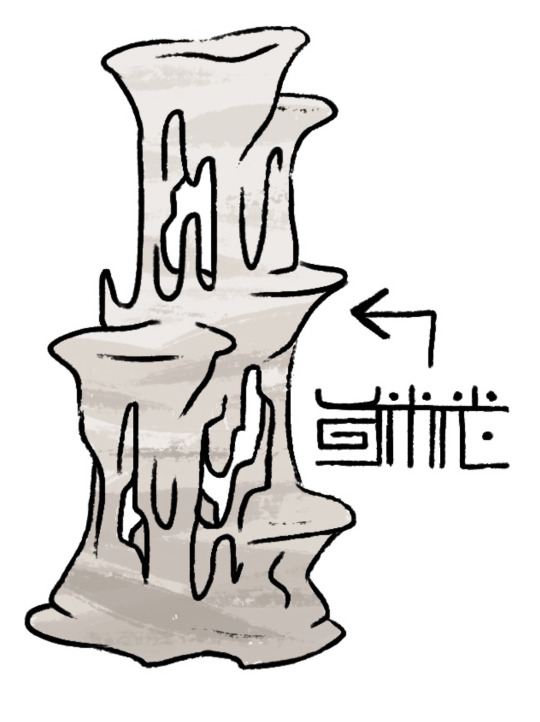
When this isn't enough to meet their mineral intake needs, some akada will just straight up eat rocks and crystals. Their teeth are strong enough to make this not impossible, though it's hardly a pleasant process. Condiments may be used to alleviate the process.
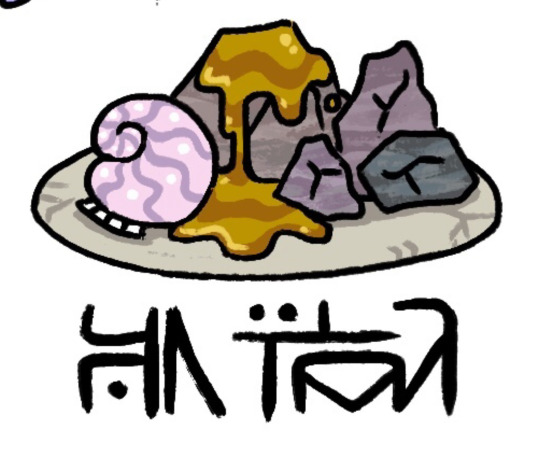
EATING HABITS
In most cultures, food is consumed in small portions at irregular intervals. There are no standardized times where one is expected to eat, nor is there any conception of “early day” or “late day” foods the same way we associate certain types of food with breakfast, lunch, dinner, or dessert.
PREDATORS
As large herbivores, there are many predators that occasionally attempt to prey on akada. This is, understandably, something that akada are not huge fans of, so they have developed several ways of fighting back. Many cities are encased in walls too tall for the predators to get past or are equipped with turrets to shoot them with pellets as a nonlethal deterrent. Other groups have attempted to drive their predator species to extinction, mostly unsuccessfully. Most of the time, though, they just avoid areas known to have predators present or use repellent spray to get them to leave them alone.
RELATIONSHIPS WITH OTHER ORGANISMS
There are a handful of small parasites that may infect akada, such as digestive endoparasites or worms that burrow through their shells. All of these creatures are just considered to be mild annoyances, and many treatments are available to get rid of them.
On a larger scale, several entire ecosystems are reliant on the presence of akada-built structures, just like how cities on Earth have become havens for certain species. These urban ecosystems are even more complex than their Earthen equivalents, as most large Almudian cities being built primarily from clay means plants are able to grow on and around them uninhibited, providing many more areas for creatures to make their homes.

Body Rhythms
SLEEP

Similar to their eating habits, rather than having one long period of sleep at one specific time of day, akada have several short naps throughout the day. A side effect of this is that the scheduling for most other parts of their lives, such as work, are very nonstandardized, since there’s no possible time that could work for everyone. People are just allowed to customize their work schedules to best fit their sleep schedule (or lack thereof).
Communication
LANGUAGE
Akada, like humans, communicate mostly through vocalizations, though some cultures rely more on bodily movements or other nonverbal cues. A few settlements use exclusively nonverbal signing as language, mainly extremely cold/dry areas where their faces are too heavily covered up to speak.
BODY LANGUAGE
Most akada body language is in some way based around part of their body recoiling/retracting inwards or stretching outwards. This is especially noticeable in any fear/surprise-based expressions, where their entire heads may compress inward. Other behaviors include arm gesticulation, antenna wiggling, mouth scrunching, and neck lowering/raising. I have not yet mapped out exactly what these gestures mean, but I'll get around to it eventually. Maybe. Hopefully.
Society
SOCIAL STRUCTURE
Akada are very sociable and tend to live in intricately interconnected communities. These communities range wildly in size, with smaller ones having only a few dozen akada and larger ones having tens of thousands. The larger a group is, the less intimate they are, but there's always some degree of connection.
Most of the work done by an akada is done for the sake of their community. They are naturally inclined to put others' needs before their own, and any purely selfish act done at the expense of others is immediately shamed.
There are no strictly-defined nations on Almud in the same way there are on Earth. Cultural associations, trade routes, and political alliances may tie smaller collections of cities together, but they aren’t surrounded by borders. Territorialism between groups is low to nonexistent.
DISPUTES
Due to how slowly they move, akada lack the athleticism required for any sort of large-scale war, leaving diplomacy as the only viable option. When a dispute occurs, long discussions will be held in order to find the outcome that would best benefit everyone involved. These discussions have a tendency to move along at a snail's pace, though.
If battles do happen, they are performed either entirely with ranged weapons or on the back of Almud’s closest equivalent to a horse. Combat such as this has become increasingly rare in recent history.
IN-GROUP/OUT-GROUP MENTALITY
Akada are typically more welcoming of outsiders than humans, thanks in part to the aforementioned intrinsic drive to help and be kind to others, but they aren't immune to bias by any means. Exactly how prone to bigotry akada are varies between different regions of the globe. Generally, societies with an abundance of resources, like those near the equator, are typically more accepting, since they have less reason to push away others, while far north or far south groups tend to be slightly more paranoid and xenophobic. These are not universal by any means, however.
BONDING
Akada live very community-oriented lives, which necessitates forming strong bonds with others. There is a wide variety of types of bonds they may form, encompassing really any type of connection you can think of a human forming on Earth, like distant family bonds with townspeople, closer family bonds with those they spend most of their time with, friendships with people from other towns, romantic bonds with mates, and associations with coworkers. All of this leads to day-to-day life being very dynamic and complex.
SENSE OF IDENTITY
Most of an akada's sense of identity comes from which town they reside in. As mentioned before, a single settlement of akada is functionally a massive family, so the place they grow up has a huge impact on how they act and view the world around them.
The most widespread naming convention in akada society is one or two given names, then a surname denoting their hometown. For example, if an akada was named Talo Vozenalk, it would mean "Talo from the city of Vozena." The "-alk" suffix is typically used to denote residency.
DOMESTICATION
Akada have domesticated a wide range of creatures over their history, including large herbivores to pull carts, small carnivores to ward off pests, and a variety of docile animals kept as pets.

Of these pets, one of the most popular is the zhay (again, name in the one currently existing language), an eel-like creature in the same order as akada. Zhays were originally domesticated to scare off aquatic predators and keep pests out of lake farms. They fill a similar societal role to dogs, sometimes being considered as much of a part of the family/community as an akada would be.
ART
The artform given the most importance in most cultures is ceramics and clay sculptures. Clay, as a whole, plays a very important role in Almudian society, being not just the material most buildings are built out of, but the medium of the early writing styles most modern scripts are derived from.

There are clay sculptures dating back to the earliest days of akada civilization, depicting all sorts of things, mostly culturally significant animals and historical figures. A good chunk of archaeological information about early societies comes from these sculptures.
Modern sculptures tend to take more abstract forms. There have been innumerable art movements over the years, each with their own substyles and subsubstyles, as well as snobs proclaiming their preferred style to be better than all of the others. These sorts of debates get heated very quickly.
That's all there is to say for this questionnaire. It took a very long time to fill all of this out, so I hope that it was worth reading.
Alien Questionnaire - A Biological Perspective
A while ago, somebody linked me a very comprehensive worldbuilding questionnaire. For most aspects of a fictional society, it was great, but I noticed it assumed that anyone using it was making up a fictional human society, or at least a society of beings very similar to humans. As such, there was almost nothing in the biology department, which to me is one of the best parts! Thus, this questionnaire was born.
These questions are designed to help people worldbuild from a biological foundation. As such, the questionnaire only touches lightly on other aspects of a fictional society, and is more of a jumping off point. I wrote it with the aim of using it to develop aliens, but it should be suitable for any project with non-humanoid species, such as sapient terrestrial animals.
Have fun! I'd love to see your answers :)
------------------------------------------------------------------------------
General Anatomy How many limbs do they have? Do they have limbs at all?
What are their primary manipulators? Where are they located? How does this affect their tool use, building ability, etc?
What kind of body covering do they have, e.g. hair, scales, feathers? How do they clean it? Do they shed this covering constantly, or all at once at certain times?
Can they maintain a constant body temperature? If not, how do they deal with changing environmental temperatures?
What kind of habitat do they live in? Both specific habitat, and broader such as on land vs in water.
What adaptations do they have for living in this habitat?
What kind of creature did they evolve from?
What are the similarities and differences to their closest living relatives?
What resource(s) is the most necessary and urgent for them? E.g. for many animals, but not all, it’s water.
What are some common mutations? E.g. eye colours, ability to digest lactose in humans.
What injuries or illnesses are considered disabling?
How is their healing ability? Can they regenerate? If they can, is that limited to certain body parts or a certain number of times?
Senses What senses do they have? E.g. sight, smell, electroreception, etc.
How good are those senses?
Which of their sense/s do they use the most in everyday life?
How might this choice of sense impact the way they interact with the world?
Can they detect things that Earth creatures cannot? If yes, how and why?
Movement How do they move? Do they walk, crawl, fly, etc?
If they have multiple modes of movement, which is preferred, and why?
Which part/s of their body do they use to move?
What is their speed and endurance like?
How agile are they?
Do they rely mainly on their own bodies for travel, or do they use pack animals and machines?
How often do they move around? Are they mainly sedentary, do they move a lot within a set area, do they migrate, etc?
Do they have different levels of mobility depending on age, sex, or other biological group? E.g. young barnacles are able to swim, while adults are anchored permanently to a surface.
Reproduction and Lifecycle How many sexes are there?
Are there differences between the sexes (ignoring the reproductive system)?
Are there different castes, such as in honeybees or naked mole rats? If so, what is the function of each caste?
Are differences in sex or caste used to justify discrimination or hierarchy? How might these ideas differ in different populations?
Do they have a concept of gender? If so, is gender affected by sex, caste, or some other factor?
How do they attract a mate? Do they release a chemical into the air, do an elaborate display, etc?
Does one individual try to actively woo another, or is courtship more mutual?
What do they find attractive in members of the same species?
What is the usual reproductive partnership? E.g. two individuals, one main reproducing individual with a harem, no set partner, etc.
How long do they live?
How are young brought into the world? Live birth, eggs, spores, etc?
Is producing young a painful, dangerous process, or is it easy?
How much parental investment is there? Are there many young with little investment, or few young with a lot of investment (r vs K strategy)? Or is it somewhere in the middle?
How many offspring are produced at a time? Think about how attitudes towards children may differ between a species that produces one or two, and a species that produces dozens or even hundreds at a time.
How do they grow? Are they born looking like miniature adults, gradually growing bigger? Do they have specific phases of high growth, like puberty? Do they have a larval phase, metamorphosis?
How self-sufficient are they as young? Can they move around and feed themselves as soon as they are born? Do they require parental care?
What is the usual structure of childcare? Single or multiple parents/related individuals? Communally raised?
Is sex purely for reproduction, or does it serve other purposes?
What kind of sexuality is considered the norm? This doesn’t just refer to same/other sex pairings, but the culture around sex in general.
Diet and Foodchain What is their diet? Are they carnivores, omnivores, frugivores, insectivores, etc?
Do they feed off an unusual source, for example rocks, metals, or (in appropriate settings) something like magic or souls?
What physical adaptations do they have for this diet?
Is their diet very restricted, or can they have a wide range of foods?
How often do they eat? What is the culture around mealtimes, if any?
Are they prey for other organisms? For each other?
If they are, how do they deal with it? Do they fight back, have barriers, or do they accept it as a part of life?
If they are hunters themselves, what is their attitude to killing other organisms? Are they respectful? Prideful of their kill? Is it completely trivial?
If they are hunters, how do they hunt? Are they solitary or packhunters? Are certain members of the group designated to hunt?
Are the results of foraging or hunting shared, or is it everyone for themself?
Are they parasitic, parasitised, or in a symbiotic relationship with any other organisms?
Body Rhythms How often do they sleep?
What time of the day are they most active? Are they nocturnal, diurnal, crepuscular?
Do they generally sleep for one long period a day, multiple shorter periods throughout, or something in between?
Do they sleep to cope with extreme temperatures or bad conditions, i.e. hibernate or aestivate?
Do they have any biological processes that disrupt their life e.g. moulting, reproductive cycles, etc?
If yes, how does their society accommodate for these processes? Does it accommodate them at all?
Communication What is their main method of communication? Sound, visuals, scent, etc? Think about their main sense and how this would affect communication.
What is their body language like? What small moving parts might aid their body language?
If they have multiple methods of communication, are they all given equal weight, or is one considered higher than others?
Society How sociable are they?
If social, what is the usual social structure?
Are there hierarchies? How strict or relaxed are the roles?
How are disputes usually settled? Is it more common to be violent or appease the other party?
If not social, what is the reaction to being with other individuals? Do they become aggressive or stressed? Do they tolerate each other?
What is the usual size of a community? Do they have communities at all?
Do they have an in-group vs out-group mentality? If so, how strong is it? This generally relates to how scarce or plentiful resources were during their evolution, and how territorial their ancestors were.
What kind of bonds do they form?
On the spectrum of individualistic to community-oriented, where do they fall?
Do they have a strong sense of personal identity? Think about how this might tie in with the previous question.
What are the main things they derive identity from? Occupation, gender, family ties, etc?
Do they have names? If yes, how are these names formed? Are they given by another party or chosen by the individual?
Have they domesticated any creatures? If so, what do they use these creatures for?
Do they have any unusual relationships with other creatures on their planet (beyond predation, parasitism or mutualism)?
Do they produce art? What are their main forms of artistic expression? Think about how this will be linked to their main sense(s), communication method, and/or primary manipulators.
------------------------------------------------------------------------------
GLOSSARY Primary manipulator: Main body part used to manipulate objects, e.g. hands in humans, trunks in elephants, feet in parrots.
Sedentary: Inactive, staying in the same place.
Caste (reproductive): A group within a species with differences in body type and reproductive ability.
Symbiosis/Mutualism: Interactions where both parties benefit, e.g. cleaner fish getting a meal in exchange for picking irritating parasites off larger fish.
Aestivate: To become inactive during hot or dry periods, usually involving being sealed in mucus or soil e.g. lungfish, snails.
Reproductive cycle: Regular hormone fluctuations that affect an animal’s fertility or attitude towards breeding. The cycles can range from months to years and can include things such as antler growth in male deer, heat cycles, and menstruation in humans.
#third try at posting this. hoping it actually works#worldbuilding#speculative biology#spec bio#alien#xenobiology#art#my art#akada#Almud
2K notes
·
View notes
Text
brooo where are the rdo heads. need friends to go bowling w groups of npcs with get drunk etc
0 notes
Text
its kind of weird that the bible doesnt have any stories of people getting turned into animals or trees or anything. the closest is the pillar of salt which comparatively sucks. the quran has you covered tho
You are already aware of those of you who broke the Sabbath. We said to them, “Be disgraced apes!” So We made their fate an example to present and future generations, and a lesson to the God-fearing.
(possibly metaphorical but i think a metaphorical reading doesnt make sense with talking about "their fate")
even though there's all sorts of weird stuff in the almud i dont think it has any metamorphosis tales
16 notes
·
View notes
Text

A handy perk of having wings is impromptu shelter from the rain. Artfight attack on @eiliakins of their character Almud
3 notes
·
View notes
Text
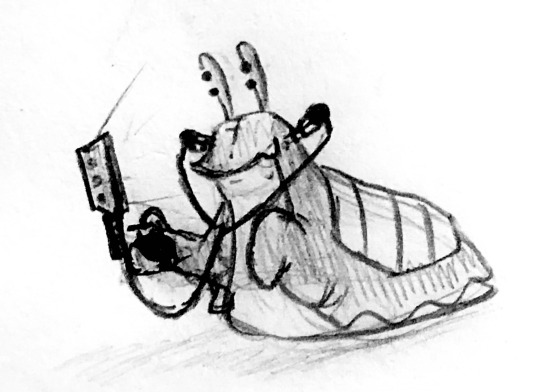
Akada headphones are designed to wrap around the antennae and deliver vibrations directly onto their surface. Meanwhile, their phones are controlled not by touchscreens, but by an attachment shaped a bit like a wiimote nunchuk with a selfie stick growing out of it.
This is the most common design, at least. There is a wide diversity of models available, each with some unique feature meant to set them apart from the others. Personal technology like this has been becoming increasingly common lately thanks to a recent tech boom, leading to all sorts of quality of life improvements.
Unfortunately, this golden age of innovation comes at a cost. The more technologically advanced a community becomes, the more likely they are to be plagued by a threat the likes of which they have never had to deal with before. One with the power to tear communities apart. One with the power to end the tech boom singlehandedly. One with the power to cause mass annoyance on an unprecedented scale.
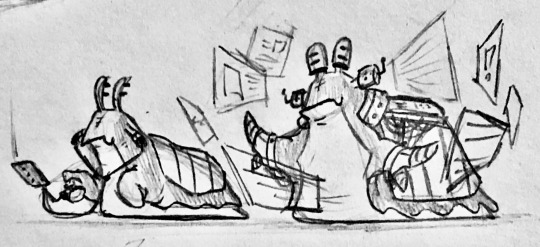
Techbros.
Drew Birdweasel using a phone
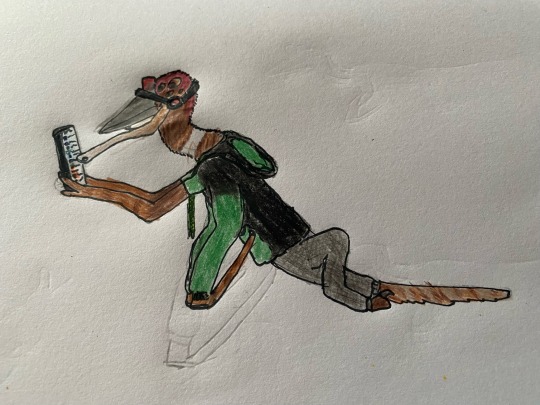
Birtweessil on da phone waht will he listen to
If you also have sophonts reblog this with them using a phone and special headphones I wanna see your goobies
17 notes
·
View notes
Text
Lucine in all his Almud-y glory!
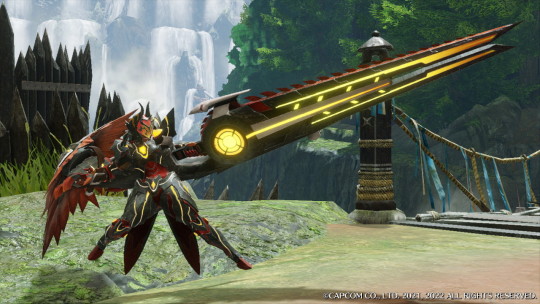
11 notes
·
View notes
Text
Municipio de

Mogán está localizado en la esquina Sudoeste de Gran Canaria. Su terreno está repleto de montañas y una amplia zona de valles cubierta de bosques y vegetación.
Este municipio ofrece dos formas totalmente distintas de vida. Con el mismo nombre nos encontramos el puerto y el pueblo, uno pesquero y turístico y otro agrícola y menos orientado al turismo. Puerto Mogán combina la villa pesquera con una hermosa urbanización turística, playa y puerto deportivo. Incluso este puerto tiene dos zonas diferenciadas y delimitadas: un muelle para los pescadores y los pantalanes para embarcaciones de lujo y de pesca deportiva. El pueblo está situado en medio de un barranco por cuyo amplio cauce se pueden apreciar numerosas plantaciones de frutas tropicales.
Mogán, municipio marinero que además cuenta con grandes extensiones de cultivo, posee extraordinarios productos gastronómicos entre los que cabe destacar la gran calidad y variedad de aguacates y mangos
Mogán, conocido por poseer el mejor clima de Europa y uno de los mejores del mundo gracias a su ubicación geográfica, otorga a sus visitantes una temperatura media al año de 24º C. y sol prácticamente los 365 días del año garantizando el buen tiempo durante sus vacaciones.
Igualmente en Mogán encontramos la zona turística de Puerto Rico, que se caracteriza por el alto grado de urbanización de la zona, proceso que, cada vez con más frecuencia, podemos observar en el sur de Gran Canaria.
Con sus más de 16 km. de franja costera, Mogán cuenta con un total de 19 magníficas playas para todos los gustos, desde insólitas y tranquilas como Medio Almud, Los Frailes, Tiritañas o Veneguera hasta playas con diversidad de servicios como Amadores, Anfi, Playa de Mogán, Puerto Rico, Las Marañuelas o Taurito.
Festividades
En el municipio de Mogán se celebran varias fiestas, que ocupan la mayor parte de la estación veraniega. Algunas de estas fiestas ocupan un papel más relevante que otras por su tradición y fervor de los fieles.
La fiestas en el municipio comienzan el 30 de mayo en honor de Nuestra Señora María Auxiliadora, en Motor Grande, Puerto Rico y finalizan en agosto con la celebración anticipada de Nuestra Señora Inmaculada Concepción en Barranquillo Andrés.
Pero si sobre el 13 de junio estamos en Mogán, podremos celebrar la fiesta más importante del municipio en honor a San Antonio de Padua.
0 notes
Text
Almud Masterpost
UNDER RECONSTRUCTION
#art#pencil on paper#alien#slug#akada#almud#spec bio#speculative biology#spec evo#speculative evolution#xenobiology#creature design#drawing#sci fi#guess who just learned that the name I gave to this planet is also the name of an antiquated unit of measurement#good to know it's not#like#an obscure slur or something#my art
55 notes
·
View notes
Text
Ausencia de luz. Parte 1
ORACIÓN
Padre, en la guía de tu Espíritu ayúdame amado Señor a ser luz en este mundo, a orar y predicar a los que no conocen tu Palabra, pero sobre todo a reflejar el carácter justo y santo de Cristo en todas mis acciones, siendo lleno de paz, perdón, sabiduría y amor; por amor a Cristo, amén.
LEE LA PALABRA DE DIOS
“Vosotros sois la luz del mundo; una ciudad asentada sobre un monte no se puede esconder. Ni se enciende una luz y se pone debajo de un almud, sino sobre el candelero, y alumbra a todos los que están en casa. Así alumbre vuestra luz delante de los hombres, para que vean vuestras buenas obras, y glorifiquen a vuestro Padre que está en los cielos”, Mateo 5:14-16
REFLEXIONA
Los versículos de hoy hacen una comparación entre la luz y la oscuridad, relacionando el mal con la oscuridad y el bien con la luz. Esto denota o significa que el mal es la ausencia de luz, la carencia de virtud o el deterioro de funcionalidad de lo bueno.
Hay varias palabras en la Biblia que se usan para referirse al mal, en Mateo 6:34 se usa la palabra Kakós (κακός), "Así que, no os afanéis por el día de mañana, porque el día de mañana traerá su afán. Basta a cada día su propio mal (kakós)."; esta Palabra "Kakós" generalmente se traduce como "malo" o "mal" y es utilizado para describir cosas que son inherentemente malas o dañinas, no solo moralmente, sino también en términos de calidad o funcionalidad.
En Mateo 7:17-18 se usa la palabra “saprós”, "Así, todo buen árbol da buenos frutos, pero el árbol malo da frutos malos. No puede el buen árbol dar frutos malos (saprós), ni el árbol malo dar frutos buenos."; se traduce como"podrido" o "corrupto ", y se usa para describir cosas que se han deteriorado o están en un estado de descomposición.
En Mateo 6:13 se usa la palabra ponerós (πονηρός), "Y no nos metas en tentación, mas líbranos del mal; porque tuyo es el reino, y el poder, y la gloria, por todos los siglos. Amén."; aquí "mal" en este contexto puede entenderse como el mal en general o el "malvado", o haciendo referencia a una influencia o entidad maligna.
Es decir, que el mal también se relaciona con la inacción del bien, o cuando alguien que puede hacer el bien no lo hace. Indiferencia, insensibilidad, falta de disposición para ejecutar el bien como enseña Romanos 12:21: “No seas vencido de lo malo, sino vence con el bien el mal.”
Entonces, podemos reflexionar sobre tres definiciones bíblicas del mal: primero, la falta de funcionalidad de algo; segundo el deterioro o descomposición de ese algo; y tercero, la influencia maligna.
Entonces, ¿a qué nos debe llevar este conocimiento de lo que significa el mal? Lo profundizaremos en el devocional de mañana.
ALABANZA
youtube
Escúchanos en Spotify
null
0 notes
Text
Episode 3: The End of a Reign
Disaster has struck, and the Empress of Tin is no more. Her captain is dead, and her guardian Lelequna has been slain. A clash of two river titans, the lukwata and a monstrous crocodile, destroyed the Empress of Tin as though she was little more than a handful of twigs. The cargo of fruit and vegetables has been scattered, and her heavy goods are sunken now in the deep hole where the lukwata lives. More deaths were prevented, however. Clever use of enchantments befuddled both of the reptiles, keeping them from more actively making attempts on the lives of those aboard the boat as Vaïstä ensorcelled them. Umid kept Peppina from drowning not once, but twice, plucking her from the river before it took her to its depths. Shiloh sprang in and out of the river many times, ferrying not only Vaïstä to safety but also leading efforts to rescue the young girl Adsa as she was snagged on the roots of the great trees on the river's bank.
Now, however, the group stands wet and almost completely alone on the bank of the river, watching as the last shreds of the Empress of Tin are washed away. They are safe for now as the rain pours around them but Captain Almud's adult children, Samis and Ulun, are nowhere to be seen. The sun has yet to rise as the thunder dies away, and the last vestige of the Empress vanishes into the night. A storm lantern, its glow finally extinguished in a tribute to the boat, its guardian, and its captain.
0 notes
Text

La Virgen de la Almudena es la patrona de Madrid
El nombre Almudena tiene una etimología árabe, pues desde el 711 hasta 1492, España estuvo bajo dominio árabe. La primera etimología que se nos ocurre es: "al-mudayna", diminutivo de “Medina”, ciudad de Arabia Saudita. Otra posible etimología sería "almudith", depósito de trigo, o "Almud", medida (de trigo).
Cabe señalar que el nombre antiguo antes de la conquista musulmana era "María la Grande" (Santa María la Mayor).
Hay varias tradiciones sobre el origen del santuario. La más conocida relata que la imagen de la Virgen de la Almudena fue escondida en un muro en el año 712, al inicio mismo de la conquista musulmana. Al comienzo de la reconquista, en el año 1085, el rey Alfonso VI de León mandó buscar la estatua. Algunas piedras del muro caen y dejan al descubierto la estatua con dos velas aún encendidas, a pesar de los siglos transcurridos.
Otra tradición es la de una aparición mariana al héroe castellano Rodrigo Díaz de Vivar, llamado “El Cid”.
También se informa que la estatua fue esculpida por Nicodemo, el que vino al encuentro de Jesús en la noche, que fue pintada por san Lucas y traída por Santiago... Pero esto es difícil de confirmar, pues el manuscrito que lo informa data de 1640. De todos modos, la estatua actual está datada alrededor del año 1500 y se atribuye a Diego Copín de Holanda, escultor de la época.
La Virgen de la Almudena es la patrona de Madrid desde 1623, lo que fue confirmado en 1646. Se celebra el 9 de noviembre en España. En 1885, el papa León XIII decidió por bula la creación de una diócesis en Madrid. Unas décadas más tarde, se comenzó a trabajar en la construcción de una catedral, sede del obispo. Así se construyó la Catedral de Santa María la Real de la Almudena.
Fue consagrada por el papa Juan Pablo II durante su cuarto viaje a España, el 15 de junio de 1993.
Enciclopedia Mariana
Dios te salve María, llena eres de gracia, el Señor es contigo. Bendita Tú eres entre todas las mujeres y bendito es el fruto de tu vientre Jesús. Santa María, Madre de Dios, ruega por nosotros pecadores, ahora y en la hora de nuestra muerte. Amén.
Créditos a "Un Minuto con María", dirección de email correo@mariedenazareth.com
0 notes
Text
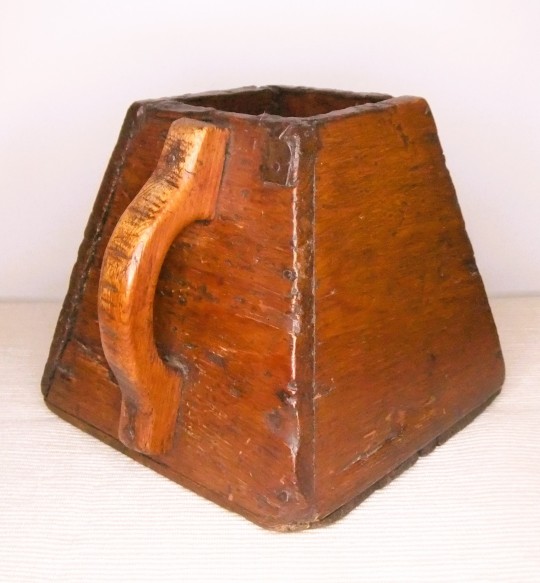
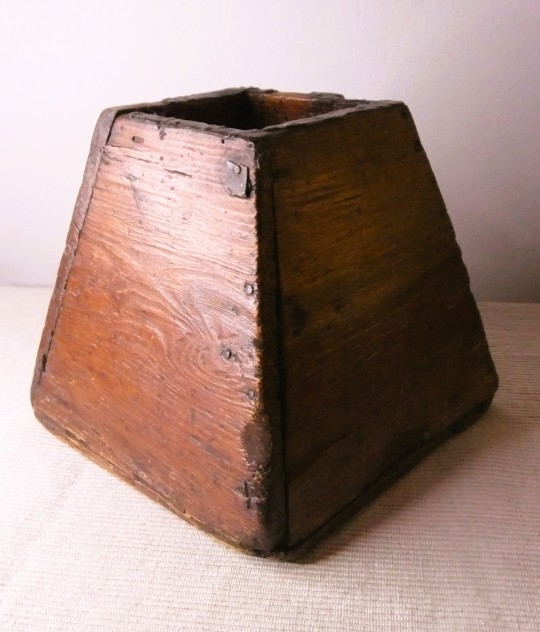
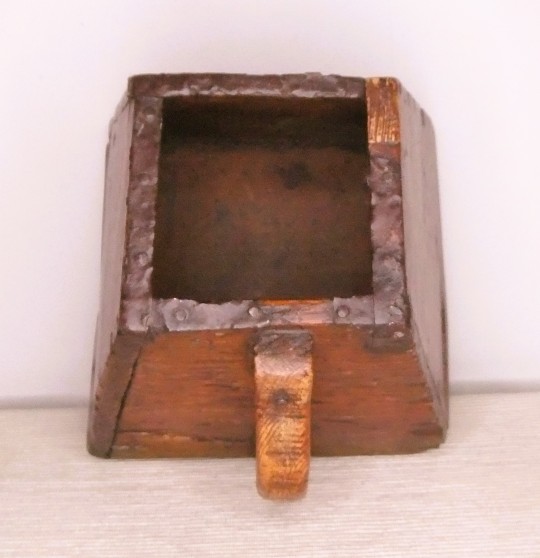
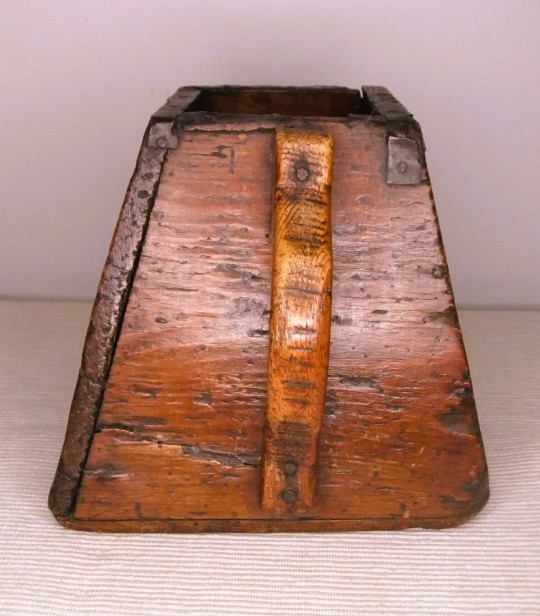
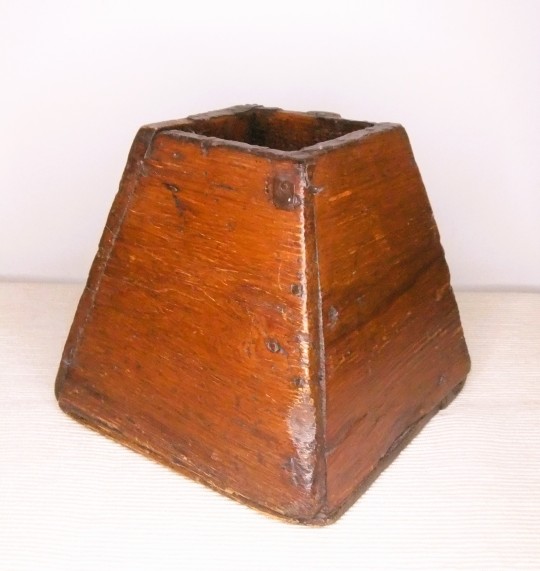



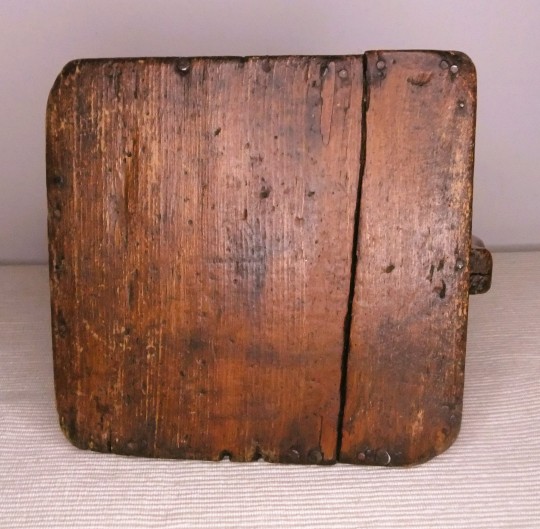
ANTIGUO MEDIO ALMUD o CELEMIN (MEDIDA DE GRANO)
SE TRATA DE MEDIO/ MIG ALMUD. SE TRATA DE UNA MEDIDA PARA ÁRIDOS O GRANO ANTERIOR AL SISTEMA MÉTRICO DECIMAL. EQUIVALE A LA 8ª PARTE DE UNA BARCELLA, ES DECIR, ALGO MÁS DE DOS LITROS
ESTE TIPO DE MEDIDAS SE USABAN EN CATALUÑA, BALEARES, ARAGON Y CASTILLA
ZONA SUPERIOR HERRADA EN PARTE
BASE : 16,7 x 16,7 cms
ALTURA: 15,5 cms
PESO: 450 grs
BONITA PÁTINA
LAS FOTOGRAFÍAS SON PARTE DE LA DESCRIPCIÓN
50 € MÁS GASTOS DE ENVIO
0 notes
Video
youtube
Encontro Galego-Luso 2023 en Vilagarcía
❤️❤️❤️❤️❤️❤️❤️❤️❤️❤️❤️❤️
Fotos y vídeos del precioso Encontro Galego Luso 2023. Ha sido una auténtica bendición y lo queremos compartir con todos vosotros. Deseamos que sea de bien para todos... los que aman la música, los que disfrutan de la comunión y el amor de Pueblos hermanos en Cristo... en todo y por todo llevando el mensaje de nuestro Dios al mundo.
❤️❤️❤️❤️❤️❤️❤️❤️❤️❤️❤️❤️
2 Corintios 13:11:
“Por lo demás, hermanos, regocijaos, sed perfectos, confortaos, sed de un mismo sentir, vivid en paz; y el Dios de amor y paz será con vosotros.
Mateo 5:15-16
“Ni se enciende una luz y se pone debajo de un almud, sino sobre el candelero, y alumbra a todos los que están en casa.Así alumbre vuestra luz delante de los hombres, para que vean vuestras buenas obras, y glorifiquen a vuestro Padre que está en los cielos.
❤️❤️❤️❤️❤️❤️❤️❤️❤️❤️❤️❤️
Siempre en su amor bendito y precioso...
Beatriz Garrido ❤️❤️❤️❤️❤️❤️❤️❤️❤️❤️❤️❤️
0 notes
Text

#palabrapredicada #palabradeamor #palabrarestauradora #palabradevida #palabraparati #palabradada #palabradefe #palabrasabia #palabraespecial #palabraoportuna #palabradeldía #palabraparami #palabrapoderosa #palabrareveladora #palabradedicada #palabraconunción #palabrademisericordia
Vosotros sois la luz del mundo; una ciudad asentada sobre un monte no se puede esconder. Ni se enciende una luz y se pone debajo de un almud,sino sobre el candelero, y alumbra a todos los que están en casa.
Mateo 5:14-15
#palabradefe#palabradevida#palabraparati#palabrareveladora#palabrarestauradora#palabraespecial#palabradeldía#palabraparami#palabraoportuna#palabrapoderosa
0 notes
Text
La enseñanza del Señor es una luz que alumbra.
Versículos de la Biblia.
Marcos 1:21-22 Y entraron en Capernaum; e inmediatamente, el sábado, entró en la sinagoga y se puso a enseñar. Y se admiraban de Su enseñanza; porque les enseñaba como quien tiene autoridad, y no como los escribas.
En la sinagoga, el Señor Jesús enseñaba al pueblo con autoridad. Cuando el hombre cayó en pecado, rompió la comunión que tenía con Dios, y como resultado, quedó sumido en la ignorancia respecto al conocimiento de Dios, lo cual primeramente produjo las tinieblas y luego a la muerte. El Salvador-Esclavo vino, como luz del mundo (Jn. 8:12; 9:5), a Galilea, tierra de las tinieblas, a fin de alumbrar al pueblo asentado en sombra de muerte (Mt. 4:12-16). Su enseñanza liberó la palabra de luz para alumbrar a los que estaban en la oscuridad de la muerte, a fin de que recibieran la luz de vida (Jn. 1:4). Ya vimos que lo primero que hizo el Salvador-Esclavo en Su servicio evangélico fue predicar el evangelio. Lo segundo que hizo el Esclavo de Dios en Su servicio a los hombres caídos como Salvador-Esclavo fue llevar a cabo tal enseñanza para hacer que el pueblo saliera de las tinieblas satánicas y entrara en la luz divina (Hch. 26:18).
Por la soberanía de Dios, el Señor Jesús fue criado en la región de Galilea y comenzó a predicar y a enseñar no en Judea, sino en Galilea. Según el relato bíblico, Galilea no sólo era una región despreciada, sino también un lugar de tinieblas. Acerca de esto, Mateo 4:15-16 dice: “Tierra de Zabulón y tierra de Neftalí, camino del mar, al otro lado del Jordán, Galilea de los gentiles; el pueblo asentado en tinieblas vio gran luz; y a los asentados en región y sombra de muerte, luz les amaneció”. Esto muestra que cuando el Señor Jesús anduvo por Galilea, Él era una gran luz que resplandecía en las tinieblas e iluminaba a los que estaban asentados en región y sombra de muerte. En particular, lo que brillaba como una gran luz era la enseñanza del Salvador-Esclavo. Cada palabra que salía de Su boca era iluminadora. Así que, mientras enseñaba a la gente, la luz los iluminaba. De esta manera, los que yacían en tinieblas fueron iluminados por la enseñanza del Señor.
Vosotros sois la luz del mundo; una ciudad asentada sobre un monte no se puede esconder. Ni se enciende una luz y se pone debajo de un almud, sino sobre el candelero, y alumbra a todos los que están en casa. Así alumbre vuestra luz delante de los hombres, para que vean vuestras buenas obras, y glorifiquen a vuestro Padre que está en los cielos.
S. Mateo 5:14-16 RVR1960.
R. P. H.
0 notes